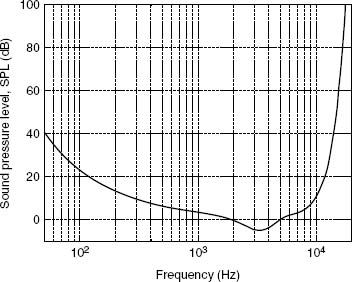5.2 ABSOLUTE THRESHOLD OF HEARING
The absolute threshold of hearing characterizes the amount of energy needed in a pure tone such that it can be detected by a listener in a noiseless environment. The absolute threshold is typically expressed in terms of dB SPL. The frequency dependence of this threshold was quantified as early as 1940, when Fletcher [Flet40] reported test results for a range of listeners that were generated in a National Institutes of Health (NIH) study of typical American hearing acuity. The quiet threshold is well approximated [Terh79] by the non linear function
![]()
which is representative of a young listener with acute hearing. When applied to signal compression, Tq(f) could be interpreted naively as a maximum allowable energy level for coding distortions introduced in the frequency domain (Figure 5.1).

Figure 5.1. The absolute threshold of hearing in quiet.
At least two caveats must govern this practice, however. First, whereas the thresholds captured in Figure 5.1 are associated with pure tone stimuli, the quantization noise in perceptual coders tends to be spectrally complex rather than tonal. Secondly, it is important to realize that algorithm designers have no a priori knowledge regarding actual playback levels (SPL), and therefore the curve is often referenced ...
Get Audio Signal Processing and Coding now with the O’Reilly learning platform.
O’Reilly members experience books, live events, courses curated by job role, and more from O’Reilly and nearly 200 top publishers.

